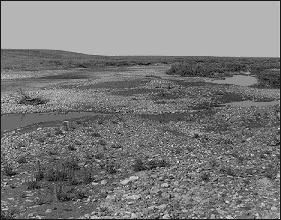
 |
| Plate 29.--Classification: SYSTEM Riverine, SUBSYSTEM Lower Perennial, CLASS Unconsolidated Bottom, SUBCLASS Sand, WATER REGIME Permanently Flooded, WATER CHEMISTRY Fresh. Channel meanders, a typical feature of lower perennial streams, are especially well developed along this section of the Yellowstone River. (Yellowstone National Park, Park County, Wyoming; May 1985; Photo by F. C. Golet) |
 |
| Plate 30.--Classification: SYSTEM Riverine, SUBSYSTEM Lower Perennial, CLASS Aquatic Bed, SUBCLASS Rooted Vascular, DOMINANCE TYPE Nymphaea odorata, WATER REGIME Permanently Flooded, WATER CHEMISTRY Fresh-Circumneutral, SPECIAL MODIFIER Excavated. This channel was dug by man in an unsuccessful attempt to drain the wetland. Plants in the Palustrine wetland bordering the channel include sedge (Carex lasiocarpa), sweet gale (Myrica gale), leatherleaf (Chamaedaphne calyculata), and Atlantic white cedar (Chamaecyparis thyoides). (Washington County, Rhode Island; July 1977; Photo by F. C. Golet) |
 |
| Plate 31.--Classification: SYSTEM Riverine, SUBSYSTEM Lower Perennial, CLASS Unconsolidated Shore, SUBCLASS Cobble-Gravel, WATER REGIME Temporarily Flooded, WATER CHEMISTRY Fresh. Feltleaf willow (Salix alaxensis) grows along the edge of the stream. The entire channel is flooded for only a few weeks after snowmelt each year. (Kavik River, North Slope Borough, Alaska; July 1985; Photo by F. C. Golet) |
 |
| Plate 32.--Classification: SYSTEM Riverine, SUBSYSTEM Lower Perennial, CLASS Unconsolidated Shore, SUBCLASS Sand, WATER REGIME Seasonally Flooded, WATER CHEMISTRY Mixosaline, SOIL Mineral. Young tamarisk (Tamarix gallica) plants are scattered over this sand flat. (Socorro County, New Mexico; April 1978; Photo by P. B. Reed) |